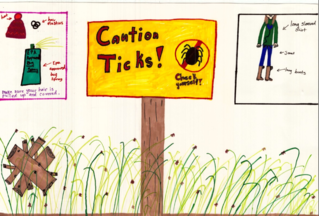
Each year, Maine CDC holds a K-8 poster contest to encourage awareness of ticks and the ways to prevent Lyme disease. This is one of last year’s poster contest winners. Our theme for 2017 is “Be tick smart,” and we are accepting submissions until April 28. For more information on how you or your child can participate, please visit http://www.maine.gov/lyme and click on “Lyme Disease Awareness Month Activities.”
During National Nutrition Month, we recognize the Special
Supplemental Nutrition Program for Women, Infants, and Children (WIC), which is
funded by the USDA Food and Nutrition Services. WIC provides checks for supplemental
foods, health care and social service referrals, breastfeeding promotion and
support and nutrition education to low-income and nutritionally at risk, pregnant,
post-partum and breastfeeding women, and to infants and children up to age five.
Studies have shown the WIC Program has a positive impact in
the following health outcomes:
- Reducing premature births
- Reducing low
and very low birth-weight babies
- Reducing fetal and infant deaths
- Reducing the incidence of low-iron anemia
- Increasing access to prenatal care earlier in
pregnancy
- Increasing pregnant women’s consumption of key
nutrients such as iron, protein, calcium, and Vitamins A and C
- Increasing immunization rates
- Improving diet quality
- Increasing access to regular health care
In Maine, WIC local agency clinic services are contracted
statewide in each of the eight public health districts. Clinic services
include: program eligibility, income verification, nutrition assessment and education,
breast feeding education, hemoglobin screening, anthropometrics, referrals, and
checks for healthy foods.
The average monthly participation in Maine is approximately 20,000.
The projected cost of food per participant for federal fiscal year 2016 is $59.45 per month. More than three-quarters of women who
accessed the program in federal fiscal year 2016 initiated breastfeeding, with
more than one-third breastfeeding longer than three months and more than
one-quarter breastfeeding longer than six months. More than 16 percent of WIC children ages two through five who had been overweight are now at a healthy weight.
U.S. CDC has launched a new campaign - Syphilis Strikes Back - to raise awareness about recent increases in the number and rate of syphilis cases. In 2015, the United States experienced the highest number and rate of reported primary and secondary syphilis cases in more than 20 years.
Forty-nine cases of primary, secondary, and early latent syphilis were reported to Maine CDC in 2015, which represents a significant increase over the five-year median of 19 cases.
In 2015, the statewide syphilis
rate was 3.7 per 100,000. Rates were highest in Somerset and Cumberland
counties, with rates of 11.7 per 100,000 and 9 per 100,000 respectively.
Of the reported cases, 61 percent
were diagnosed in southern Maine (26 cases in Cumberland County, four cases in
York County) and 22 percent of cases were diagnosed in central Maine (Kennebec
and Somerset counties).
Most of the cases (76 percent) were
among 25 – 54-year-olds. Since 2011, the proportion of syphilis cases in people
age 40 and older has been increasing steadily from 30 percent in 2011 to 47 percent in 2015.
The majority of syphilis cases
identified as male (41 cases or 82 percent). The number of early syphilis cases
among females rose from one reported case in 2011 to nine reported cases in
2015.
The predominant mode of
transmission associated with reported syphilis cases was male-to-male sexual
contact (32 cases or 65 percent).
For more information about syphilis, visit https://www.cdc.gov/std/sam/2017syphilis.htm
|